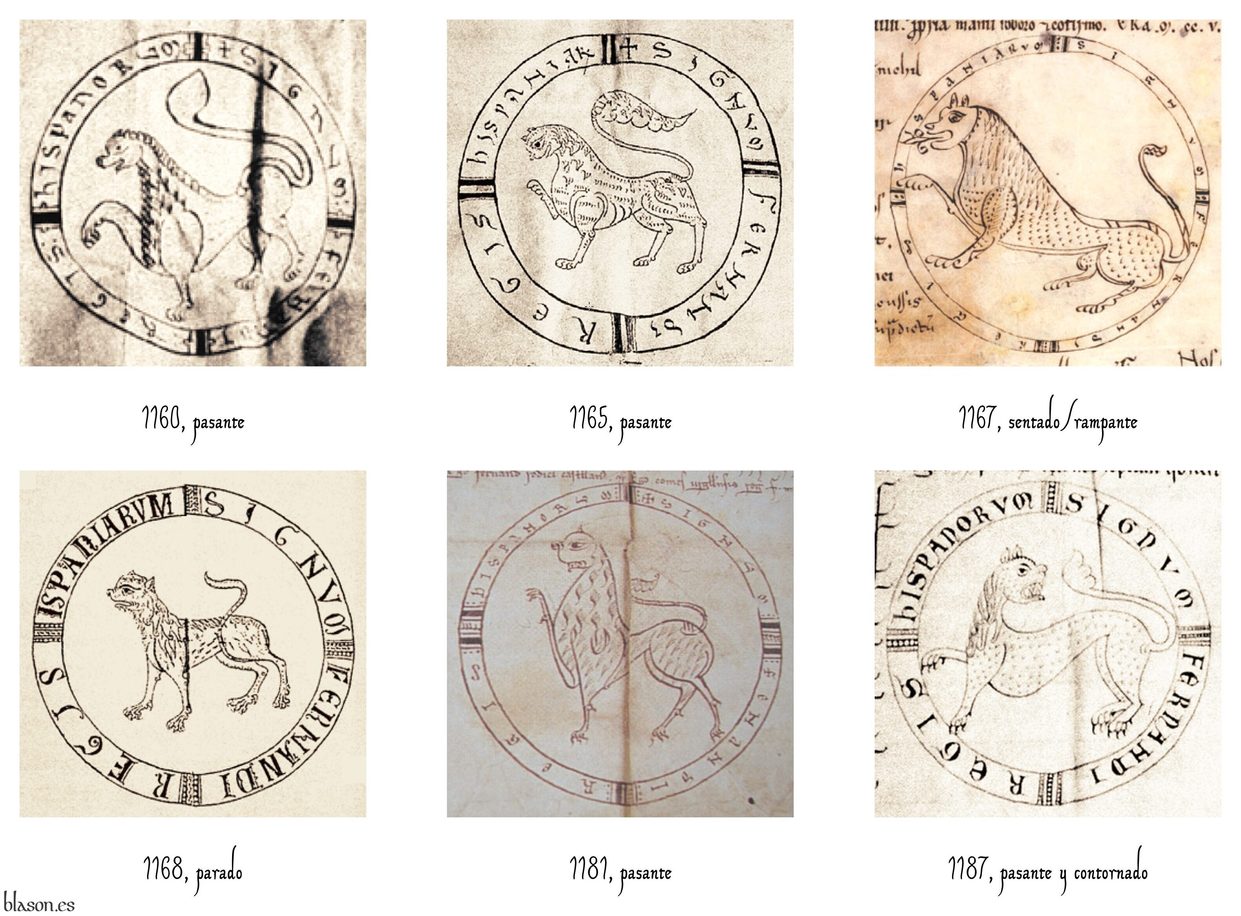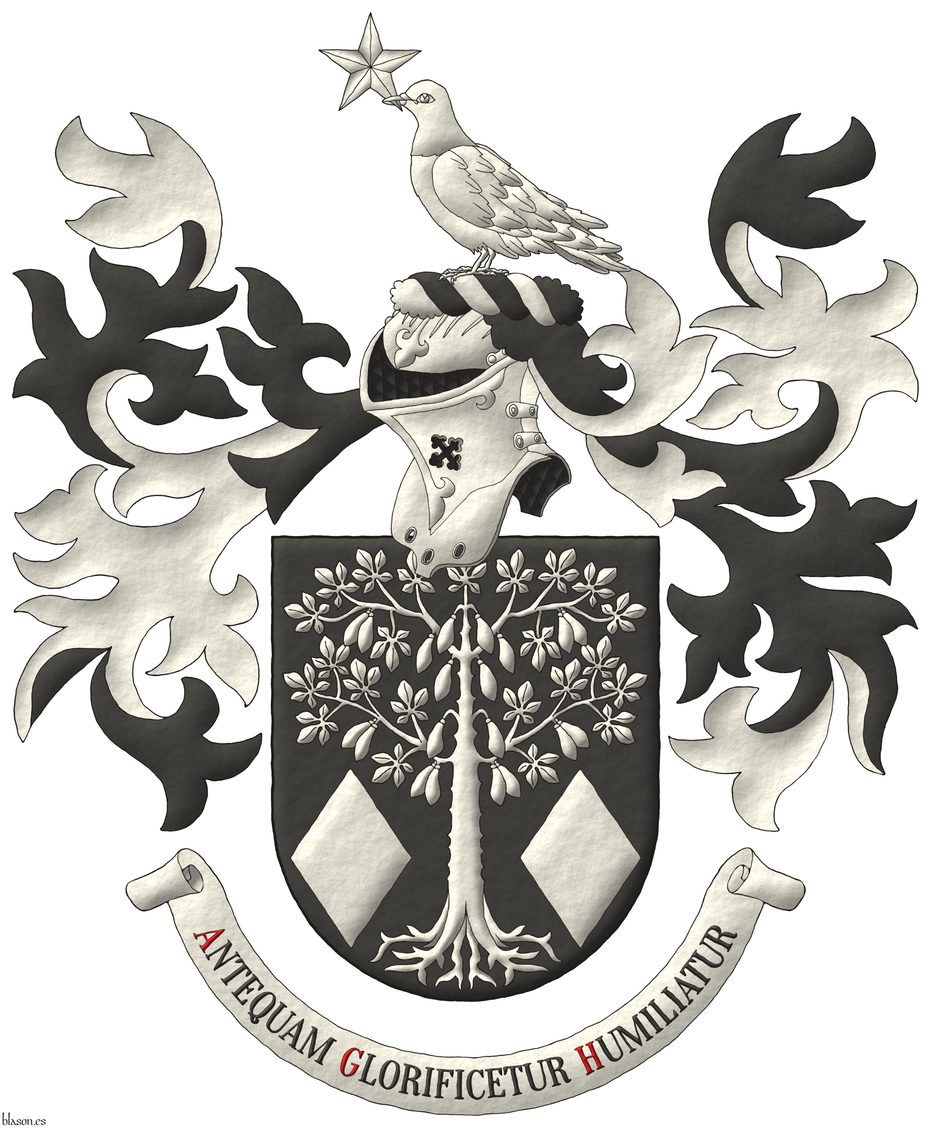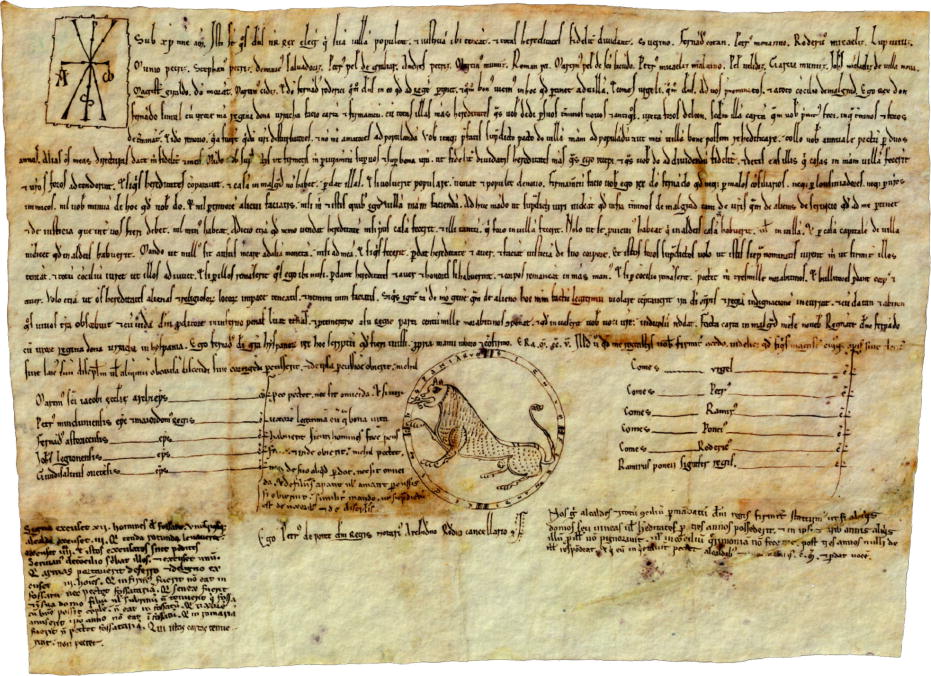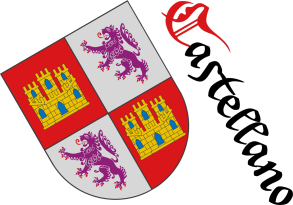
Leonor Plantagenet, corona real abierta
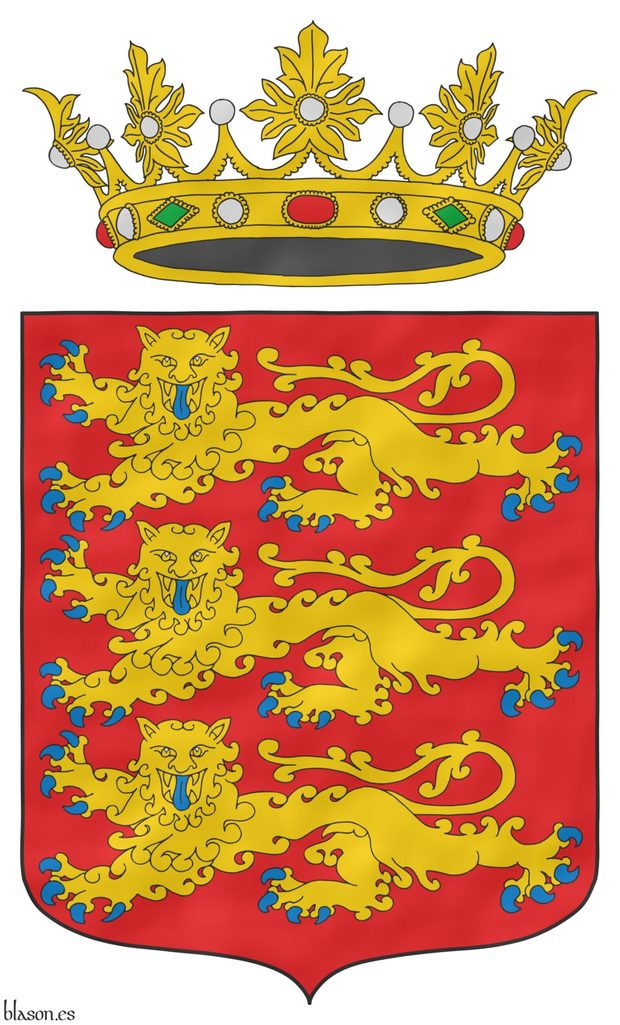
Princess of England and Queen Consort of Castile from 1170 to 1214.
Gules, three lions, passant, guardant, in pale Or, armed and langued Azure. Crest: An open royal crown Or.
Escudo de gules, tres leopardos en palo de oro, armados y lampasados de azur. Timbrado de una corona real abierta.
Armorial bearings of the queen interpreted by me as follows: the shape of the shield is pointed and rounded; both the field, the three leopards, and the open royal crown have been enamelled with flat tints of gules and metal or, with details in azure, vert, and metal argent; the three leopards and the crown are outlined in sable; and the whole composition has a watercolor finish.
She was the daughter of Henry II of England and Eleanor of Aquitaine, wife of Alfonso VIII of Castile, and mother of 10 children documented in historical records, with her eldest daughter being Queen Berenguela of Castile.
Blazon keywords: Without divisions, Gules, Or, Azure, Three, Leopard, Armed, Langued, In pale, Crest, Open royal crown and Crown.
Style keywords: Ogee, Plain tincture, Outlined in sable and Watercolor.
Classification: Interpreted, Personal, Coat of arms, House of Plantagenet, Kingdom of England and Kingdom of Castile.
Bearer: Leonor Plantagenet.


Leonor Plantagenet and Alfonso VIII
[ Gules, a castle triple towered Or, port and windows Azure, masoned Sable ] accolé with [ Gules, three lions, passant, guardant, in pale Or, armed and langued Azure ].
[ Escudo de gules, un castillo de oro, aclarado de azur, mazonado de sable ] acolado de un [ escudo de gules, tres leopardos en palo de oro, armados y lampasados de azur ].
Arms of the King and Queen of Castile interpreted with: the escutcheons' shapes pointed and rounded; the field of each shield, the castle, and the three leopards enamelled in flat tints of Gules and metal Or, with windows, claws, and tongues in Azure; and the whole composition finished with a raised line technique.
[Medél, R.; 1846; page 38] provides a heraldic description of the leopard.
Blazon keywords: Without divisions, Gules, Or, Azure, Three, Leopard, Armed, Langued, In pale, Sable, One, Castle, Port and windows and Masoned.
Style keywords: Ogee, Plain tincture, Outlined in sable, Tilted shield and Freehand.
Classification: Interpreted, Personal, Accolé arms, House of Plantagenet, Kingdom of England and Kingdom of Castile.
Bearer: Leonor Plantagenet.


Ferdinand II of Leon
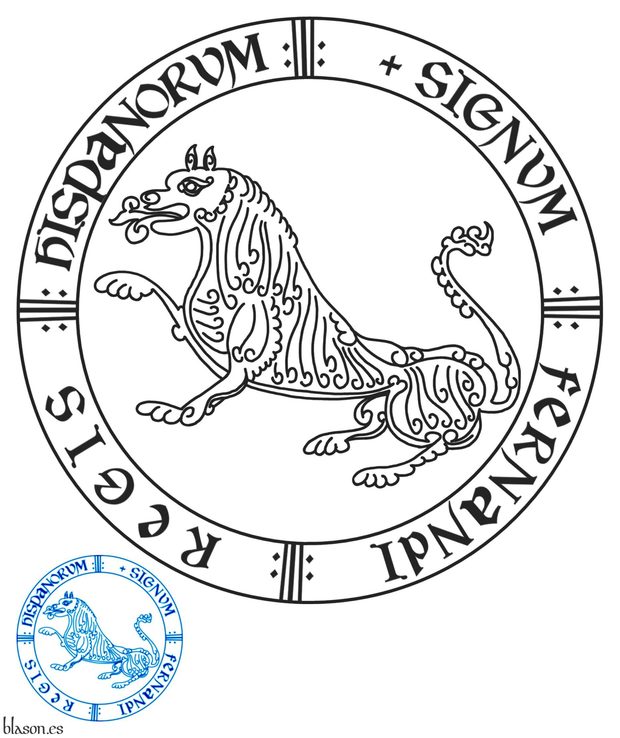
Round seal, a lion sejant. Circular motto: «Signum Fernandi Regis Hispanorum».
Sello rodado, un león sentado. Divisa circular: «Signum Fernandi Regis Hispanorum».
Existing seal interpreted by me as follows: the shape of the seal is circular; the motto is written in sable on its outer ring; inside, a seated lion that begins to be rampant and will eventually become so; y the whole rendered in flat sable ink; y the result is an impression in azure ink.
For the outline of the lion I have followed the round seal of the king in his «Charter of Benavente» [Fernando II de León; 1167], in which I consider the lion to be seated; although it could also be interpreted as rampant, or as intending to be so, as it will ultimately appear in the arms of his son, King Alfonso IX of León.
For the delineation of the motto I have followed the round seal of the king in his «Charter of the Alfoz of Benavente» [Fernando II de León; 1181], in which the lion, unlike the previous one, is clearly in a passant posture.
In [Martín Fuertes, J. A.; 2002] four other round seals of King Fernando II of León can be consulted:
- from the year 1160 (A.C. de León, number 4168) with a lion passant,
- from the year 1165 (A.C. de León, number 1041) with another lion passant,
- from the year 1168 (A.C. de León, number 170) with a lion statant, also described as arrested or at rest, as mentioned in [Avilés, J.; 1725a; page 37] and [Avilés, J.; 1780a; page 42].
- from the year 1187 (A.C. de León, number 1067) with a lion passant and regardant, that is, with its head turned toward the sinister side of the round seal, a posture described, for example, in [Avilés, J.; 1725a; page 55] and [Avilés, J.; 1780a; page 61].
In attitudes of the lion of Ferdinand II the attitudes discussed in this article are illustrated.
Blazon keywords: Without divisions, One, Lion, Sejant and Motto (identification).
Style keywords: Round, Plain tincture and Sealed.
Classification: Interpreted, Personal, Seal and Kingdom of León.
Bearer: Ferdinand II of Leon.


Ferdinand II, Signum Regis Hispanorum
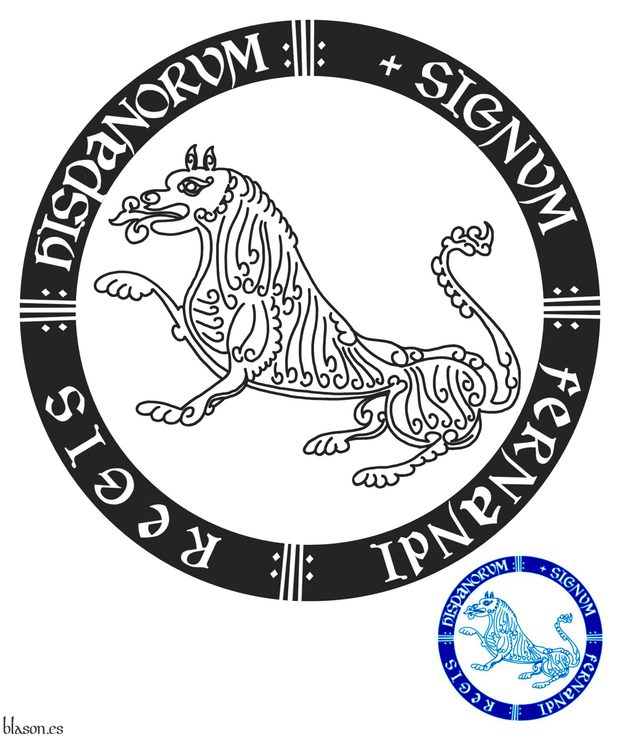
Born in 1137, King of León from 1157 to 1188, died in Benavente on January 22, 1188.
Round seal, a lion sejant. Circular motto: «Signum Fernandi Regis Hispanorum».
Sello rodado, un león sentado. Divisa circular: «Signum Fernandi Regis Hispanorum».
Existing seal interpreted by me as follows: the shape of the seal is circular; the legend is written within an outer black border; inside, a seated lion, not so much rampant and even less passant; the whole rendered in flat sable ink; and the result glazed with azure ink.
I use the term "legend" for its identifying purpose regarding King Fernando II of León; note that among the terms motto, legend, device, and war cry, all referring to texts in the blazon, different nuances and meanings can be found.
Blazon keywords: Without divisions, One, Lion, Sejant and Motto (identification).
Style keywords: Round, Plain tincture and Sealed.
Classification: Interpreted, Personal, Seal and Kingdom of León.
Bearer: Ferdinand II of Leon.


Ferdinand II, imaginary coat of arms
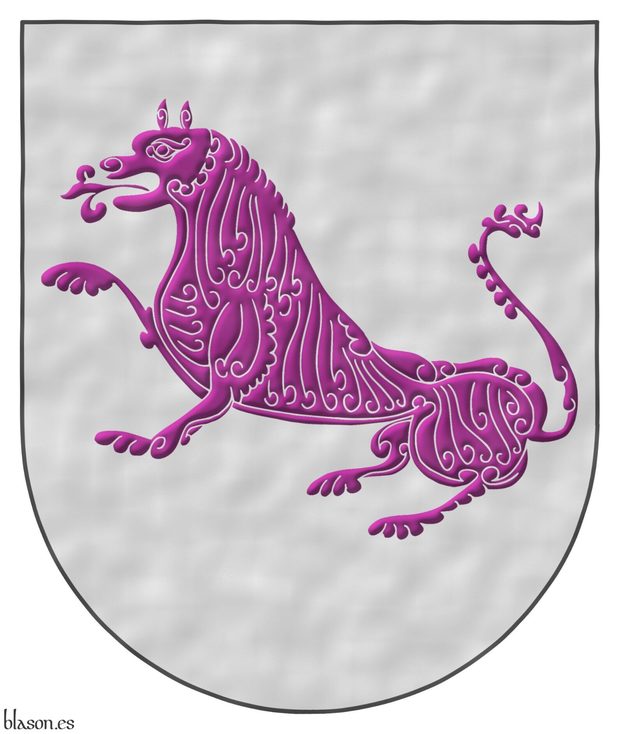
Argent, a lion sejant erect Purpure.
Escudo de plata, un león sentado de púrpura.
Imaginary coat of arms of King Fernando II of León, which I have developed based on his seal and the arms of his successor, with: the shape of the coat of arms is semi-circular; the field enameled in flat argent; the lion enameled in purpure and illuminated; and the whole rendered with a watercolor finish.
For this imaginary coat of arms I have chosen a representation of the lion in a posture similar to that of the great seal appearing in [Fernando II de León; 1167], which is sejant ~ «sentado» in Castilian, although beginning to rise «sejant erect».
It should be noted that we are in a pre-heraldic period where the possible attitudes of the lion were not yet clearly defined, although several of them are already anticipated in the great seals of Fernando II, as can be seen, for example, passant in [Fernando II de León; 1181] and in other attitudes in the photographs of [Martín Fuertes, J. A.; 2002].
Blazon keywords: Without divisions, Argent, Lion, Purpure and Sejant.
Style keywords: Semi-circular, Illuminated, Outlined in the field tincture and Watercolor.
Classification: Interpreted, Imaginary, Coat of arms and Kingdom of León.
Imaginary bearer: Ferdinand II of Leon.


Attitudes of the lion of Ferdinand II
Selection of various lion attitudes: passant, statant, sejant, almost rampant and in one case regardant, in 6 examples of the great seals of King Fernando II of León from 1160 to 1187.
These 6 seals come from the following 3 sources: [Fernando II de León; 1167], [Fernando II de León; 1181] and [Martín Fuertes, J. A.; 2002].
Categories: Personal, Seal, Round, Kingdom of León, Without divisions, One, Lion, Passant, Statant, Sejant, Rampant, Regardant and Motto (identification).
Root: Ferdinand II of Leon.


Plastic execution, a phase with three activities
Layout and tincture:
- This stage's goal is to draw freehand the ordinaries and charges which will be placed upon the blazon and tincture them in plain colors and metals.
- The result is the definitive coat of arms in plain tincture.
Ornamentation and accompaniment:
- It aims the creation of the ornament and, where appropriate, of their complementary heraldic objects, for example, seal, badget, flag, bookplate, etc., all of them determined by the final composition of the coat of arms.
- Its result is the shield with its ornament and its additions in plain colors and metals.
Lighting and final art:
- Its objective is, depending on the cases, lighting or shading of ordinaries, figures, crest, etc., and give the final finish to the heraldic objects.
- The result is the shield, its ornament and complements finished as plastic work reviewable by the future owner. This could drive to a refining cycle returning to some of the earlier phases.


![Ver [Fernando II de León; 1167] en referencias bibliográficas. Libro abierto, hojas de plata, filo de oro, guardas de gules, tapas de sable.](../css/Libro.Bibliografia.png)
Fernando II de León; 1167

Fernando II, King of León, «Carta Puebla de Benavente», Historical Archive of the City Council of Benavente, dated November 1167.
It is a document in which King Fernando II of León grants privileges to Benavente with the aim of repopulating this town.
The original document is a parchment measuring 60 x 43 centimeters, adorned in the upper right corner, right according to the heraldic criterion, with a Chi Rho from which hang an alpha and an omega. In what could be considered the navel of the charter is a rolled seal of the king formed by a lion, which I consider closer to rampant than passant, surrounded by a circular motto that reads «Signum Fernandi Regis Hispanorum» ~ «Sign of Fernando, King of the Spains». Additionally, this rolled seal is accompanied by the names of members of the chancery and prelates of the Kingdom of León, to confirm the grants recorded in the «Carta Puebla de Benavente».
This charter, also called the «Fuero de Benavente», is a beautiful example of local law and, since its promulgation in 1167, served as a model for other towns. In the following years, similar charters to that of Benavente were adopted in other towns of León, Asturias, and Galicia, with the one in La Coruña being a notable example.
The objective of the provisions of this charter was to favor the repopulation and settlement of new settlers in the town of Benavente, and its successful operation in this aspect led to its application in other places.
The original document is kept in the Municipal Archive of Benavente, forming part of its collection of royal privileges of Benavente. There is also a «facsimile» edition, like the one that illustrates this bibliographic reference, published in 2002 by the Benavente City Council on the occasion of the Commemoration of the VIII Centenary of the Benavente Courts.
Bibliographical reference of century XII.
The author is Fernando II de León.
Bibliographic reference mentioned in the following articles:
External links:
- Benavente remembers Fernando II of León.
- Churches in the parish of Renueva.
- Facsimile of the Carta Puebla de Benavente.
- Carta Puebla in PDF.
Internal resources: FernandoII.24.Facsimil.CartaPueblaBenavente.pdf in armorial, Fernando II of León, key 104..

Continue with: Fernando II de León; 1181.
-
Language
-
Categories of heraldry
-
Divisions of the field
- Without divisions
- Party per pale
- Party per fess
- Party per bend
- Party per bend sinister
- Tierce
- Tierce sinister
- Tierced per pale
- Tierced per fess
- Tierced per bend
- Tierced pallwise inverted
- Quarterly
- Quarterly per saltire
- Gyronny
- Party per fess, the chief per pale
- Party per pale, the sinister per fess
- Party per fess, the base per pale
- Party per pale, the dexter per fess
- Chapé
- Chaussé
- Embrassé
- Contre-embrassé
- Party per chevron
- Enté
- Enté en point
- Flanched
-
Metals
-
Colours
-
Furs
-
Other tinctures
-
Ordinaries and sub-ordinaries
-
Diminutives of the ordinaries
-
Geometric charges
-
Composite ordinaries
-
Inanimate charges from Nature
Atom, Crescent, Diamond, Emerald, Estoile, Increscent, Lightning flash, Moon, Mount, Mullet, Mullet of four points, Orbital, Plough of Ursa Major, Rainbow, Ray of the sun, River, Sea, Snowflake, Sun, Sun in splendour, Sun of May, Trimount, Water and Wave.
-
Vegetal charges from Nature
Acorn, Apple, Apple tree, Ash, Bluebonnet, Camellia, Chrysanthemum, Cinquefoil, Cornflower, Dogwood flower, Double rose, Elm, Fleur de lis, Flower, Gourd, Holm oak, Hop cone, Kapok tree, Laurel, Lily, Linden, Lotus flower, Madonna lily, Mexican cedar tree, Oak, Olive tree, Palm tree, Plantain plant, Pomegranate, Poplar leaf, Rose, Shamrock, Sunflower, Thistle, Tree, Tulip, Vine and Wheat.
-
Animal charges from Nature
Badger, Bald eagle, Barbel, Barn owl, Bear, Beaver, Beetle, Bighorn sheep, Blackbird, Boar, Brach hound, Bull, Doe, Dog, Dolphin, Dove, Eagle, Elephant, Falcon, Female figure, Fish, Flame, Fly, Fox, Frog, Goat, Goldfinch, Goose, Heron, Horse, Hummingbird, Jaguar, Lark, Leopard, Lion, Lion passant, Lion rampant guardant, Lioness, Lynx, Male figure, Martlet, Merino ram, Owl, Panther, Parrot, Peacock, Pelican, Pelican in her piety, Puffin, Quetzal, Raven, Roe deer, Rooster, Savage, Seagull, Serpent, She-wolf, Stag, Starling, Talbot, Tyger, Vulture, Warren hound and Wolf.
-
Parts of natural charges
Arm, Beak, Branch, Caboshed, Chest, Claw, Covert, Dorsal fin, Eagle claw, Ermine spot, Escallop, Feather, Foot (palmiped), Foreleg, Forepaw, Hand, Head, Heart, Hoof, Leaf, Neck, Ostrich feather, Palm frond, Paw, Roe deers' attires, Shoulder, Sprig, Stags' attires, Stem, Swallow-tail, Tail, Tail addorsed, Tail fin, Talon, Tooth, Trunk, Trunk (elephant), Two hands clasped, Two wings in vol, Udder, Wheat spike, Wing and Wrist.
-
Artificial charges
Ace of spades, Anchor, Anvil, Arch, Arm vambraced, Armillary sphere, Arrow, Axe, Bell, Bell tower, Beret, Bonfire, Book, Bookmark, Bow, Branding iron, Bridge, Broken, Buckle, Cannon, Cannon dismounted, Cannon port, Canopy roof, Carbuncle, Castle, Celtic Trinity knot, Chain, Chess rooks, Church, Clarion, Clay pot, Closed book, Club, Column, Comb, Compass rose, Conductor's baton, Cord, Covered cup, Crozier, Crucible, Cuffed, Cup, Cyclamor, Dagger, Double vajra, Drum, Ecclesiastical cap, Fanon, Federschwert, Fleam, Four crescents joined millsailwise, Galician granary, Garb, Gauntlet, Geometric solid, Grenade, Halberd, Hammer, Harp, Host, Hourglass, Key, Key ward, Knight, Knot, Lantern, Letter, Line, Loincloth, Menorah, Millrind, Millstone, Millwheel, Monstrance, Mortar, Mullet of six points pierced, Nail, Non-classic artifact, Norman ship, Number, Oar, Oil lamp, Open book, Page, Pair of scales, Parchment, Pestle, Piano, Pilgrim's staff, Plough share, Polish winged hussar, Port, Portcullis, Potent, Quill, Ribbon, Rosette of acanthus leaves, Sabre, Sackbut, Sail, Scroll, Scythe, Sheaf of tobacco, Ship, Skirt, Spear, Spear's head, Stairway, Star of David, Step, Sword, Symbol, Tetrahedron, Torch, Tower, Trident, Trumpet, Turret, Two-handed sword, Wagon-wheel, Water-bouget, Wheel, Winnowing fan and With a turret.
-
Immaterial charges
Angel, Archangel, Basilisk, Dragon, Dragon's head, Garuda, Golden fleece, Griffin, Heart enflamed, Justice, Mermaid, Our Lady of Mercy, Ouroboros, Paschal lamb, Pegasus, Phoenix, Sacred Heart of Jesus, Saint George, Sea-griffin, Trinity, Triton, Unicorn, Winged hand and Wyvern.
-
External elements
-
Heraldic creations
-
References
-
Formats
-
Keywords on this page
Port and windows, Watercolor, Armed, Artist, Azure, Bibliography, House of Plantagenet, Castle, Crest, Round, Ogee, Regardant, Crown, Open royal crown, Outlined in sable, Outlined in the field tincture, Motto (identification), In pale, Coat of arms, Accolé arms, Sealed, Ferdinand II of Leon, Personal, Gules, Illuminated, Imaginary, Interpreted, Langued, Leonor Plantagenet, Leopard, Lion, Masoned, Semi-circular, Or, Statant, Passant, Argent, Without divisions, Purpure, Rampant, Kingdom of Castile, Kingdom of England, Kingdom of León, Seal, Sejant, Century XII, Plain tincture, Three and One.

![Leonor Plantagenet and Alfonso VIII [ Gules, a castle triple towered Or, port and windows Azure, masoned Sable ] accolé with [ Gules, three lions, passant, guardant, in pale Or, armed and langued Azure ].](../escudo_armas/LeonorP.23.Matrimonio.jpg)
